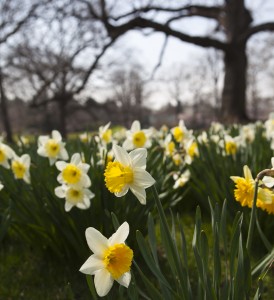Confusion for Groundhogs and Gardeners Alike
Posted in Around the Garden, Gardening Tips on February 2 2012, by Plant Information Specialists
The New York Botanical Garden’s Plant Information Specialists and the Home Gardening Center share a wealth of experience, enlightening visitors with their knowledge of indoor and outdoor plants, ornamentals, vegetable gardening, identification, and growing requirements–to name but a few of their specialties.
 It was nearly 60 degrees here at The New York Botanical Garden yesterday, a misplaced spring day that brought with it a number of questions from our Twitter followers concerned for the future of their plants. As Sonia Uyterhoeven outlined only a few weeks ago, this strange back-and-forth with warm and cold temperatures has been wreaking havoc on the plants’ growth cycles, confusing some of them into blooming early and leaving gardeners wondering if they’ll have anything to show come spring.
It was nearly 60 degrees here at The New York Botanical Garden yesterday, a misplaced spring day that brought with it a number of questions from our Twitter followers concerned for the future of their plants. As Sonia Uyterhoeven outlined only a few weeks ago, this strange back-and-forth with warm and cold temperatures has been wreaking havoc on the plants’ growth cycles, confusing some of them into blooming early and leaving gardeners wondering if they’ll have anything to show come spring.
For spring-blooming flowers, the bad news is that it’s a “one and done” agreement–if high temperatures now push these plants into their spring phase early, there will be no second bloom post-winter. The good news is that if we have long stretches of weather in the high 30s and low 40s, those growths that are blooming early will last for a very, very long time. At this point the long-range forecast is still looking promising. But look at your average meteorologist’s win ratio and you’ll take predictions with a grain of salt.
With conflicting reports from Punxsutawney Phil and Staten Island Chuck (full name Charles G. Hogg) leaving us at an impasse during today’s shadow showdown, who knows what we’ll end up with? Last year we had 36 inches of snow on the ground by this time; right now we’re still looking at green grass. It leaves us wondering if trying to forecast the arrival of spring specifically on a groundhog’s shadow is a worthwhile idea after all, considering the weather has been so out of the ordinary. Can any of us remember a January being so warm, with temperatures averaging eight degrees Fahrenheit above the norm?
Because we haven’t had “winter” weather, whereby plants go into dormancy and essentially shut down their growth to wait out the cold, plants are putting out new growth well before the last day of frost–considered April 15. It leaves them unprepared for any sudden turn in our fortunes when it comes to the cold; the new growth is vulnerable to damage from just a few hours of below freezing temperatures. Despite the fact that the newly released USDA Hardiness Zone Map has re-zoned our area from Zone 6a/6b to Zone 7a/7b, this is still an abhorrent weather pattern even in the warmer zone.
Even with the long-term forecast suggesting that we’ll continue coasting until spring, climate data over the past 30 years suggests that the chances of a frost occurring during the next ten weeks are near 100%. But again, this is a notably strange year.
For those with confused plants at home, our advice is to delay your pruning and fertilizing until much later in the spring. This will discourage further new growth. And as Sonia has explained, plants that are jumping the gun will be only slightly worse for wear due to the experience, and should bounce back. You can protect your befuddled bulb foliage when the temperature drops by covering it with pine boughs.
As of right now, we just have to wait and see what further oddities await.


Thank you so much for this wonderful article! I’ve been tooling around the net looking for information as I’ve seen the hue and cry raised amongst gardeners re: the effects of this unseasonable winter. This has answered all my questions and I’m just jazzed to find your blog.